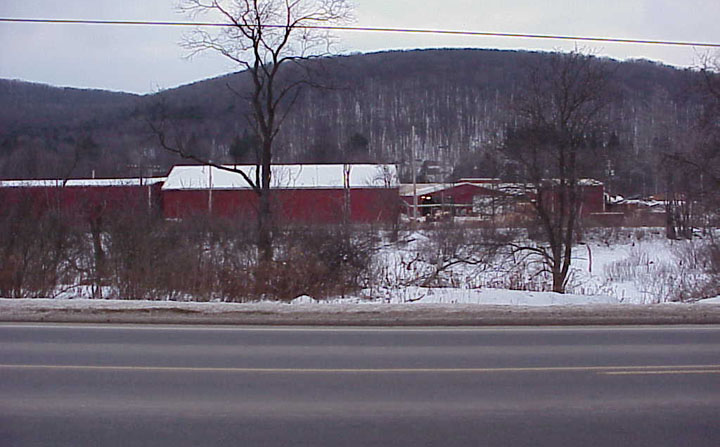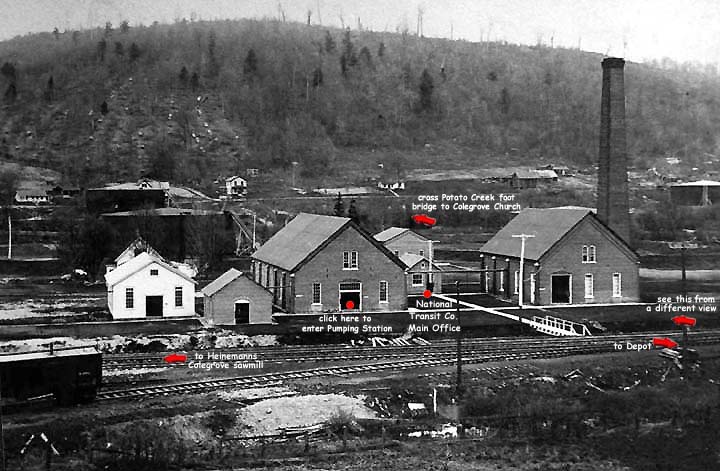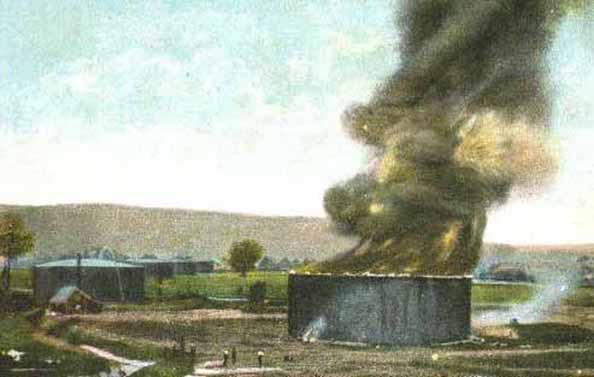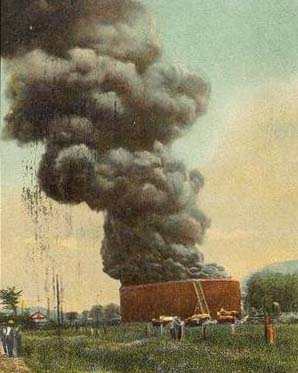There were two oil tanks stuck by lightning
on Thursday morning at 3:15 A.M. June 22nd (1892) at Colegrove, 7 miles south
of Smethport. They were both struck at
about the same time. I was told not 3 minutes apart. Sam Ramer
and I went to see them burn. We went after dinner, with a horse and
rig. The tanks were burning full blast
by the time we got there.
A tank burns about 12 hours before it boils over
and about that long afterwards, or, as long as the oil lasts. As soon
as it is discovered that any of the tanks are
struck, they telegraph for help to all the principle towns around.
That, it seems, would be unnecessary, unless, as in this case, the tanks
were struck during the night hours; for about
half or more of the people in the country round turn out as soon as they
see the smoke, and that can be seen for many miles
in every direction. It rolls up as large and blacker than any thunderstorm
I ever saw. The farmers in the neighborhood load up their plows and
take
them along for they know they will be needed &
it will be possibly 12 or more hours work and good pay. The hardware
stores around are speedily relieved of all
their shovels & of almost any kind of shovel. The idea is in the
tank, to have trenches dug and embankments throwed up around with other
tanks or property that may be near.
If all things are in readiness before the oil boils
over the shoot holes into the lower part of the tank with cannon balls about
as large as a first and let the oil out from
below into these trenches and save some of it by the use of a steam pump
for the purpose. The oil, is pumped out of the trenches and into an
unfilled tank. But is it seldom that any great
amount of oil can be saved as it is generally ready to boil over by the
time the trenches are dug and embankments thrown
up. On this occasion the pump was some miles distant and the team
mired with it on the return trip, and it failed to arrive in time to be
of any service. The one tank stood on
a high, steep bank along the mountain side & about 200 yards above the
bank of Potato Creek. The trenches that they dug around
this tank did not hold near all the oil when it boiled over & the overplus
went in a wide stream down the bank & into the creek.
The manager had forethought enough to go down the
creek about 1/2 mile & had a boom made of logs stretched across the
stream just above a large sawmill to stop the
oil when it would reach there & we were told that the boom was swung
in place none too soon. It did great damage as it went along (I
mean the oil). It burned a R.R. bridge &
two wagon bridges, the one quite a large one & all the bushes and younger
on either bank all the way down to the boom
& just as the oil was about all consumed on the water, the boom was
burned in two about the center of the stream. Had there been much
more oil afloat it would then no doubt have
burned this sawmill & possibly another little further down stream.
When tanks are struck by lightning the oil is loss
to the different individuals or small companies whose wells the oil comes
from. The Co. that owns the Pump Station
(& tanks) at this place is the Standard Oil Co. & its stock holders
are scattered all over the United States.
Each party's oil is gauged or measured as it comes
to the station & is pumped at the same time into the tanks, but the
Co. pays for none of it until it is pumped
out again into car tanks or pipe lines of their own & sold. The
loss to each stockholder in this Co. tank is said to be $10,000.
The men and boys that go to the fire to work at helping
to dig trenches & c. are paid from 40 to 50 cents an hour & sometimes
more according to the scarcity of help, but
as a rule the help is not scarce. A man & a play team are generally
paid extremely high prices. Each laborer is furnished or given
a ticket & is given a check (for his pay)
on return of the ticket when the fire is over. When the work commences
there is a couple bbls crackers, cheese & bologna
got there as soon as possibly & after the worst excitement is over there
is an excellent meal prepared for the workmen.
It seems to be a small harvest for everybody.
The liverymen make their share, too, $3.00 & sometimes more being charged
at this place
(Smethport) for a rig for a limited time (say 3 hours).
The hucksters (cake, candy & peanut vendors) hurry to the scene to catch
the loose change of the visitors.
The tanks are made of sheet iron being probably 4
ft long & are about 3/18 of an inch thick for the lower half of the
tank & taper to an eighth of an inch for
the top courses. The tanks are circular in shape & usually about
25 feet high in the center and about 40 ft in diameter. Every tank
is numbered & recorded. They are
painted red & have steps or a ladder to the top. On the roof there
is 3 or 4 gas escapes, holes about 6 inches in diameter made in the roof
to allow the gas to rise off the oil. In case
of fire in close proximity to the other tanks as it was in this case, these
escapes or holes are kept closed by a large piece
of sod thrown over them.
Each of these two tanks that were struck by the lightning
were said to hold 35,000 bbls. Oil, at the time these tanks were burned
about 55 cents per bbls.
It used to be customary to have a lightning rod put
on each tank when it was built, but it has been found out that there were
was more danger of lightning with the rods
on than without & they were ordered taken off.
After a tank has been burned, there is only about
4 ft of the sides & the bottom that is of any use, the upper part being
all melted out of shape.
There has been one & as many as three tanks burned
each year, except the first year, that the tanks were built at this place,
13 years ago. I saw where the first one had
been burned, 12 years ago & the ground where the oil had burned is still
bare of vegetation. It is a grander sight to watch a tank burn at night
but I wanted to go in the daytime so as to
see how they managed things.
Colegrove reminded me of Pine Grove,
Cumb. Co., Pa. It is situated in a glen or cove among the mountains
running east & west. Potato
Creek is a good sized stream, flows through, with
tanks and tenement houses strung along on either side in nooks & corners
& some in places bank in gaps or spaces
between the hills. The Pump Station is situated about the center on
the south side of the stream where the W.N.Y&P. Railroad runs along.
National Transit
Co.
Colegrove Pumping Station 2001

return to virtual tour



